 Beginner
Trikes Beginner
Trikes |
This is always an offbeat topic when it comes to motorcycling.
Somewhere between the automotive world and motorcycles are those
funky three wheeled contraptions otherwise known as trikes. Some
are automobile conversions, like the all too familiar VW Beetle
(the original air-cooled rear engine Bugs, not the modern retro
look-alikes) powered trikes. Then you have your motorcycle based
conversions that swap out the swingarm for their own rear end,
and some companies simply build their own chassis and add in an
automotive or motorcycle engine. So this month's "Customarily
Minded" editorial will detail something that is both a custom
modification and at the same time a possible beginner's alternative
to motorcycling.
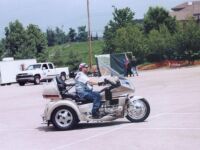 Whatever
the case, there is no denying the mystique behind the third wheel.
I finally got to sample a trike first hand at the 3rd Annual Branson
Rally in Missouri back in May of this year. J&R Trikes (in
Missouri, (573)765-5488 or toll free at 1-877-63-TRIKE, visit
their website at www.jrtrikes.net ) had a nice display present
in a back lot and was offering demo rides on their MC trike conversions.
Their kits were rather innovative, featuring NASCAR style tube
frames supported with airbag assisted independant suspension. Whatever
the case, there is no denying the mystique behind the third wheel.
I finally got to sample a trike first hand at the 3rd Annual Branson
Rally in Missouri back in May of this year. J&R Trikes (in
Missouri, (573)765-5488 or toll free at 1-877-63-TRIKE, visit
their website at www.jrtrikes.net ) had a nice display present
in a back lot and was offering demo rides on their MC trike conversions.
Their kits were rather innovative, featuring NASCAR style tube
frames supported with airbag assisted independant suspension.
So
why an article entitled "Beginner Trikes"? These things
are a far cry from what the MSF trains with. But there are simply
some cases where a person just can't handle even a 250cc motorcycle,
be it a physical handicap or simply a poor sense of balance. But
that's no reason to give up on any dreams or ideas concerning
getting into the wind. I'm going to leap right into this third
wheel topic with my DOT approved helmet on (despite the included
pictures, let the hazing begin...) and list some pros and cons
of triking as well as the obvious differences between trikes and
bikes, and in the end you can decide if there is any dissimilarity
between "trikers" and bikers.
First
off is the cost. Most companies that offer trike conversions for
motorcycles do so for flagship models, so if you're going this
route it gets rather heavy on the pocketbook. For starters you
need to donate a $10,000+ bike to the cause, and then drop at
least another $5K into the trike kit itself. If you don't have
the skills and/or a fully equipped shop at home for the necessary
conversion work, then you'll be paying out approximately 40 hours
of labor for the swap. But fret not, there are companies that
can swing kits for smaller bikes. Lehman Trikes made a kit for
a 750 Magna, and U.S. Trikes in Maryland designed a kit for the
Honda VLX 600. Jack's Salvage in Florida even did conversions
on the 450 Rebels for a time, although I believe he discontinued
this practice due to the rarity of 450 Rebel frames and swingarms.
VW Beetle based kits can be just as pricy as a bike/kit conversion
if you buy them new, however used VW trikes can be had in the
local classifieds for under $5,000 but can often be far from new
in appearance. E-Bay is a good bet for used trikes, especially
if you're hunting down a Harley Servi-car. The self fabricated
trike companies that design their own chassis also fetch automotive
grade MSRP-new prices on their products. So cost can weigh heavily
on whether or not a trike is in your future, but if you don't
mind a smaller MC-base for conversion or a used fixer upper great
bargains can be had.
Next
up we have registration and insurance. Some states treat trikes
as motorcycles, others treat them as automobiles. So registration
is definitely something you will have to look into. For those
states that treat trikes as automobiles, you get the advantage
of extra letters on a personalized plate (as automotive plates
typically have more digits than MC plates). For all the pro-choice
helmet law advocates, any mandatory helmet laws would not apply
to trikes in states that treat them as automobiles so you can
excercise your "threedom of choice." Not that I would
ever condone ditching the lid, but for those that do the long
arm of the law won't stretch over a trike in said states. Just
be wary of crossing any state lines...States that treat trikes
as automobiles also won't require a class M endorsement, so even
if you're a repeat "MSF flunkie" you can still jump
into triking in these locales. And just like any other motorcycle
or car, a trike still has two axles for the toll booths, except
you won't fall down in an oil spot while digging for pocket change.
Insurance companies often demand an appraisal to place a value
on any trike for comprehensive and collision coverage, and may
still want one if you plan on basic liability-only coverage. On
a MC conversion they may simply make a "custom parts/modifications"
ammendment to the existing policy and simply add the value of
the trike kit to the base value of the bike itself. Again it's
different from company to company. VW kits and custom chassis
fabrications may be treated as custom builds, so always look into
insurance and registration before jumping blindly into trike ownership.
Now
that we have the issues of finances and legal mumbo-jumbo out
of the way, we can carve right into the meat of this topic: Riding
a trike! The unit I sampled was a late model 1500 Gold Wing trike.
Let me start by saying that I've never been able to ride a 1500
or 1800 Wing as I'm too short to flat foot either, my only Gold
Wing experience is on older four cylinder 1100 and 1200 bikes.
So riding the latest technology in touring bikes was a real treat
in its own right, granted I didn't get to sample half of the features
on the big Wing.
Somewhere
within the vast array of instruement clusters was a 6 position
ignition switch, after a few glances I saw the key sticking out
so I gave it a turn. True to any FI Honda Gold Wing motor, she
fired right up and was purring like a kitten. After recieving
a few basic handling pointers from J&R Trike's Ray Martin
(which in a nutshell is to use your upper body and shoulder strength
to keep your long arm straight when in a turn), I squeezed the
clutch lever and eased the Wing into gear. It was kind of wierd
doing that for the first time without any feet on the ground.
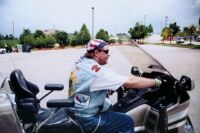 So
there I was, coasting away on three wheels for the first time
since I was three years old, except this time said three wheels
were powered by a modern fuel injected internal combustion engine
rather than foot pedals. Getting the motor trike to turn is where
the trikes are separated from the bikes. Forget what you know
about counter-steering, and if you're not already a biker or have
not attended a MSF safety class don't worry about that often heavily
debated topic as it doesn't apply to trikes. This is due in part
to the independant suspension. The trike, like a car, will lean
against the curve rather than with it as a motorcycle does, and
this leaning forces the front end back into a straight position
much as an automotive front end would perform. The faster you
try to go in a turn and the more the front end wants to straighten
out. While I didn't get to thoroughly test the theory of motorcycles
being capable of making faster turns than trikes, it felt like
the theory is accurate. One portion of the parking lot offered
a negative camber turn, the surface sloped down away from the
apex of the turn so this offered a little extra challenge as it
would make the trike lean even more in that turn. I tried several
variations of the technique that Ray offered to negotiate this
maneuver, one was trying to lean into the turn to counter the
trike's lean. It seemed to work a little better for me, but without
an extensive obstacle course to navigate I can't say which method
works better. I'll just take Ray's word for it and simply stick
to using your upper body and shoulder strentgh and keep that arm
straight. In other words, like any other motorcycle you'll want
to get some generous controlled practice time logged in parking
lots and residential streets prior to entering city traffic for
the first time. So
there I was, coasting away on three wheels for the first time
since I was three years old, except this time said three wheels
were powered by a modern fuel injected internal combustion engine
rather than foot pedals. Getting the motor trike to turn is where
the trikes are separated from the bikes. Forget what you know
about counter-steering, and if you're not already a biker or have
not attended a MSF safety class don't worry about that often heavily
debated topic as it doesn't apply to trikes. This is due in part
to the independant suspension. The trike, like a car, will lean
against the curve rather than with it as a motorcycle does, and
this leaning forces the front end back into a straight position
much as an automotive front end would perform. The faster you
try to go in a turn and the more the front end wants to straighten
out. While I didn't get to thoroughly test the theory of motorcycles
being capable of making faster turns than trikes, it felt like
the theory is accurate. One portion of the parking lot offered
a negative camber turn, the surface sloped down away from the
apex of the turn so this offered a little extra challenge as it
would make the trike lean even more in that turn. I tried several
variations of the technique that Ray offered to negotiate this
maneuver, one was trying to lean into the turn to counter the
trike's lean. It seemed to work a little better for me, but without
an extensive obstacle course to navigate I can't say which method
works better. I'll just take Ray's word for it and simply stick
to using your upper body and shoulder strentgh and keep that arm
straight. In other words, like any other motorcycle you'll want
to get some generous controlled practice time logged in parking
lots and residential streets prior to entering city traffic for
the first time.
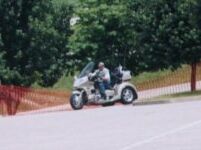 I've
both read and been told that turning is less strenuous on trikes
with solid swingarm or OEM motorcycle suspension (such as a Lehman
Trike rear end where both rear wheels travel up and down together
rather than separately as is the case with independant suspension),
but like anything else in the custom mod world it's give and take:
independant suspension offers a smoother ride but more work in
turns while a solid swingarm suspension offers less work in turns
but the entire rear end moves over bumps in the road for a rougher
ride. Six of one, half a dozen of the other...Braking was nice,
despite the extra 200+ pounds the trike kit adds to a big bike's
OEM heft. I'm not sure if J&R uses drum or disc brakes, but
whatever they use they work great. That extra weight on those
fat rear tires (that's tire-zzz, with an s) with their generous
contact patches (again with an s) really seems to assist the front
brake's "75% stopping power" substantially, without
knowing the actual numbers I'll guess the brakes are closer to
50/50 for stopping power. Once again, like a regular motorcycle,
you'll want to use both brakes as one is not as effective without
the other. While I didn't experiment with this theory, I would
also suggest never try to use only the front brake. If locking
a front brake can cause a spill on a regular motorcycle, I don't
think it will help out much with two wheels in back that aren't
braking, I would theorize that locking a trike's front wheel can
have similar effects as the front could still flop over into a
full lock and then you have what could be the triker's equivelant
of a highside. Weight wasn't something I had to contend with either,
at least for the parking lot maneuvers I engaged in. I didn't
have the opportunity(?) to try any rear wheel slides in loose
gravel or oil so I can't comment on emergency recovery. Probably
a good thing, as I didn't bring along an extra $25,000 to pay
for a damaged Gold Wing trike. I've
both read and been told that turning is less strenuous on trikes
with solid swingarm or OEM motorcycle suspension (such as a Lehman
Trike rear end where both rear wheels travel up and down together
rather than separately as is the case with independant suspension),
but like anything else in the custom mod world it's give and take:
independant suspension offers a smoother ride but more work in
turns while a solid swingarm suspension offers less work in turns
but the entire rear end moves over bumps in the road for a rougher
ride. Six of one, half a dozen of the other...Braking was nice,
despite the extra 200+ pounds the trike kit adds to a big bike's
OEM heft. I'm not sure if J&R uses drum or disc brakes, but
whatever they use they work great. That extra weight on those
fat rear tires (that's tire-zzz, with an s) with their generous
contact patches (again with an s) really seems to assist the front
brake's "75% stopping power" substantially, without
knowing the actual numbers I'll guess the brakes are closer to
50/50 for stopping power. Once again, like a regular motorcycle,
you'll want to use both brakes as one is not as effective without
the other. While I didn't experiment with this theory, I would
also suggest never try to use only the front brake. If locking
a front brake can cause a spill on a regular motorcycle, I don't
think it will help out much with two wheels in back that aren't
braking, I would theorize that locking a trike's front wheel can
have similar effects as the front could still flop over into a
full lock and then you have what could be the triker's equivelant
of a highside. Weight wasn't something I had to contend with either,
at least for the parking lot maneuvers I engaged in. I didn't
have the opportunity(?) to try any rear wheel slides in loose
gravel or oil so I can't comment on emergency recovery. Probably
a good thing, as I didn't bring along an extra $25,000 to pay
for a damaged Gold Wing trike.
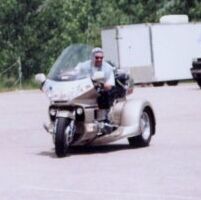 In summary, trikes are as different from motorcycles as motorcycles
are as different from trikes. The idea of never planting my feet
down was one that I had to remind myself of frequently. Coming
to complete stops and retaining both feet on the pegs was pretty
far fetched until now. You would never have to worry about losing
your footing with loose gravel or oil on the road and capsizing
while stopping at intersections. Vertically challenged folks can
actually ride those big touring rigs without the worry of ever
being able to stand one up at rest. If you happen to be physically
limited and think that riding a motorcycle can never be in your
future, think again. If your sense of balance makes you so nervous
that you've managed to repeatedly fail the MSF course, you still
have an alternative to motorcycling. Or perhaps you're simply
looking for something different, but still want to be somewhat
motorcycle-oriented. The feeling of the wind in your face is still
the same, trikes simply perform and handle differently. All in
all, you still have that "threedom of choice" to get
out and ride. It's different, and in my book different is cool.
In summary, trikes are as different from motorcycles as motorcycles
are as different from trikes. The idea of never planting my feet
down was one that I had to remind myself of frequently. Coming
to complete stops and retaining both feet on the pegs was pretty
far fetched until now. You would never have to worry about losing
your footing with loose gravel or oil on the road and capsizing
while stopping at intersections. Vertically challenged folks can
actually ride those big touring rigs without the worry of ever
being able to stand one up at rest. If you happen to be physically
limited and think that riding a motorcycle can never be in your
future, think again. If your sense of balance makes you so nervous
that you've managed to repeatedly fail the MSF course, you still
have an alternative to motorcycling. Or perhaps you're simply
looking for something different, but still want to be somewhat
motorcycle-oriented. The feeling of the wind in your face is still
the same, trikes simply perform and handle differently. All in
all, you still have that "threedom of choice" to get
out and ride. It's different, and in my book different is cool.
Stay
upright (which isn't difficult on three wheels) and keep it in
the wind. |
 Bike
Of The Month Bike
Of The Month |
Customarily
Minded Trikes
Following
the suit of adding a third wheel, this month will feature an additional
Customarily Minded machine as well. First up is an automotive
based trike. You may immediately recognize the donor vehicle to
this project. If not you didn't pay much attention to Motor Trend
and other auto mags back in the 1980's or else it's just before
your time. The mid engine automotive chassis and body was retained,
at least up to the windshield. The chassis itself was stretched
to accomodate the "motorcycle" portion which appears
to be Gold Wing in nature along with Road Glide fairing. A few
relocated controls and a fabricated seat round off the operator's
end between the motorcycle front end and the automotive body.

True believers, I submit to you the "Chauffeured
Fiero Limo-trike!
Next up is
a motorcycle conversion trike, with a slight twist. Taking a bike
from Harley Davidson's Touring stable (I believe it's a Road Glide
base, but don't hold me to the details), this customizer added
a second trailing axle, which technically makes it a penta-ike?
A designed to spec fifth-wheel tongue was added to accept a scaled
down semi trailer, now making it a nano-ike. A custom "stax"
styled exhaust system, roof mounted trumpet horns, fiberglass
sleeper, and outboard mirrors completes the 18-wheeler theme.
The trailer is constructed of light weight materials and is easily
disassembled for transport. Nay, this trailer is not intended
for regular use, it is merely for parade duty and is actually
transported on a mother truck/trailer combo from location to location,
along with the "moto-lorry" itself too.
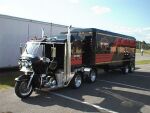
Road King
meets King of the Road?
|

